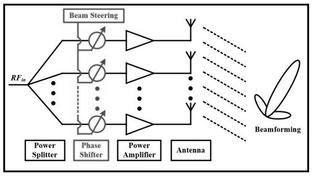Search Radar vs. Tracking Radar: Key Differences
Advertisement
This document outlines the differences between search radar and tracking radar systems. It also touches upon fundamental radar concepts and related technologies.
Radar Fundamentals
RADAR stands for RAdio Detecting And Ranging. A radar system typically consists of a transmitter, receiver, duplexer, and antenna. The radar transmits electromagnetic (EM) radio frequencies into the air. When these EM waves encounter an object, they are reflected back to the radar. This reflection is known as an echo. By comparing the transmitted signal and the received echo, the radar can determine the distance and direction of the object.
 Figure 1: Illustrative Diagram of How Radar Works
Figure 1: Illustrative Diagram of How Radar Works
Search Radar
Search radar is primarily used to locate and discover the presence of a target object. This type of radar is generally less precise and distinguishes between targets that are separated by hundreds of yards or even miles.
Key characteristics of search radar:
- Distance Coverage: Long, medium, and short ranges (20 km to 2000 km).
- High Power Density on Target: High peak power, long pulses, long pulse trains, and high antenna gain.
- Low Pulse Repetition Frequencies (PRFs): Large range bins.
- Search Options: Rapid search rate with narrow beams or slower search rate with wide beams.
Radar resolution is typically divided into two categories: range resolution and angular resolution (bearing resolution). Range resolution refers to the ability of the radar to distinguish between two targets that are close together in range, while angular resolution refers to the ability of the radar to distinguish between two targets that are close together in angle.
Tracking Radar
Tracking radar continuously emits EM waves and detects a target when it enters the path of the emitted waves. It is designed to maintain a lock on a specific target and provide accurate positional data over time.
Key characteristics of tracking radar:
- Accurate Angle and Range Measurement Required
- Minimize Time on Target: Allows for rapid processing.
- Special Tracking Techniques: Monopulse, conical scan, beam switching.
Summary of Differences
| Feature | Search Radar | Tracking Radar |
|---|---|---|
| Primary Purpose | Target detection and localization | Continuous target monitoring |
| Precision | Lower | Higher |
| Range | Longer | Varies, often shorter than search |
| Beamwidth | Wider or Narrow, depending on mode | Narrow |
| Update Rate | Lower | Higher |
| Techniques Employed | Broad search patterns | Monopulse, conical scan, beam switching |
Advertisement
 RF
RF




